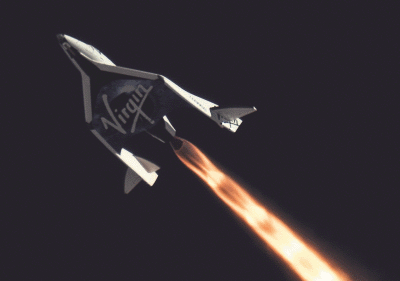Mon, May 26, 2014
Flights To An Altitude Of 50 Miles Do Not Reach The 'Karman Line'
There is a line in the sky that is recognized as the boundary between the Earth's atmosphere and "space" ... and Sir Richard Branson's SpaceShipTwo may not get passengers all the way to the line.

But the invisible threshold of space may not be Branson's most immediate concern. What may be is the report of cracks that have formed in the wings of WhiteKnightTwo, the aircraft that will carry SpaceShipTwo for launch.
The London Sunday Times reported recently that a Virgin Galactic insider said that sources with knowledge of the situation indicated that multiple cracks had formed in the wings of the aircraft, but Virgin Galactic has denied any problem with the aircraft. A company spokesman said that the aircraft had been taken out of service for its annual inspection, but "there are NO cracks in the wings." The spokesperson did say that some "adhesive imperfections which are often produced in the composite manufacturing process" had to be repaired. But those imperfections had a "negligible impact" on the performance of the aircraft.
Meanwhile, back to that invisible line. Virgin Galactic promises those who have paid up to a quarter million dollars for their opportunity to go to "space" may not fly high enough to officially get there. The "Karman Line" marking the beginning of space is considered to be 62 miles above Mean Sea Level, but VG only promises that passengers will travel to an altitude of "at least 50 miles" aboard SpaceShipTwo. The International Business Times reports that Branson and Virgin Galactic say that NASA has recognized the 50 mile altitude to be "space" since the 1960s. Astronaut wings have been awarded by NASA to pilots who flew to 50 miles as recently as 2005.

But not according to the World Air Sports Federation, the governing body for astronautical world records. While passengers flying at 50 miles will be able to experience weightlessness, the WASF will not certify that they have been to space unless they pass the 62-mile Karman Line.
Virgin Galactic CEO George Whitesides told the International Business Times that "NASA and the U.S. Air Force have a long tradition of celebrating everything above 50 miles as spaceflight, and we look forward to joining those ranks as soon as we push onward and upward. We are still targeting 100 kilometers (62 miles)."
(Images from file)
More News
Back-Taxi A term used by air traffic controllers to taxi an aircraft on the runway opposite to the traffic flow. The aircraft may be instructed to back-taxi to the beginning of the>[...]
“Our WAI members across the nation are grateful for the service and sacrifice of the formidable group of WASP who served so honorably during World War II. This group of brave>[...]
“Many aspiring pilots fall short of their goal due to the cost of flight training, so EAA working with the Ray Foundation helps relieve some of the financial pressure and mak>[...]
Blind Speed The rate of departure or closing of a target relative to the radar antenna at which cancellation of the primary radar target by moving target indicator (MTI) circuits i>[...]
Aero Linx: International Airline Medical Association (IAMA) The International Airline Medical Association, formerly known as the Airline Medical Directors Association (AMDA) was fo>[...]
 ANN's Daily Aero-Term (05.19.24): Back-Taxi
ANN's Daily Aero-Term (05.19.24): Back-Taxi Aero-News: Quote of the Day (05.19.24)
Aero-News: Quote of the Day (05.19.24) Aero-News: Quote of the Day (05.20.24)
Aero-News: Quote of the Day (05.20.24) ANN's Daily Aero-Term (05.20.24): Blind Speed
ANN's Daily Aero-Term (05.20.24): Blind Speed ANN's Daily Aero-Linx (05.20.24)
ANN's Daily Aero-Linx (05.20.24)




